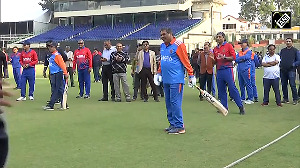Latest statistics available with the Union Home Ministry show that incidents of Maoist violence came down slightly in 2006 when compared to the figures for 2005. Till August 2006, 1,013 incidents were reported -- less than the 1,171 incidents during the same period in 2005, sources in the ministry said.
But in Chhattisgarh, as many as 469 incidents occurred during 2006, almost double of the 265 incidents reported in 2005.
In terms of casualties, 115 policemen and 401 civilians were killed till August 2006, against the respective figures of 94 and 364 for 2005.
With the launch of more coordinated operations against the rebels, more Naxalites were killed in 2006. While 144 rebels were killed in the first eight months of 2005, 170 were killed during the corresponding period in 2006, sources said.
Chhattisgarh witnessed heavy casualties among both security personnel and civilians in 2006. A total of 66 policemen were killed, compared to 21 in the same period in 2005.
Likewise, as many as 248 civilians were killed till August 2006, against 66 in the same period in 2005.
However, in terms of percentage, there was a more than 400 per cent increase in the number of Maoists killed in Chhattisgarh in 2006. Till August 2005, eight rebels were killed by security forces while the figure for the corresponding period this year is 38.
In Andhra Pradesh, another state hit by Naxal violence, the number of incidents came down from 412 during the first eight months last year to 132 till August 2006.
The number of policemen and civilians killed in Andhra Pradesh also witnessed a decline from 16 to ten, and 149 to 22 respectively during the period under review.
The number of Naxalites killed in Andhra Pradesh dropped from 111 in 2005 to 90 in 2006, they added.
The incidents of violence by Maoists came up for review at a recent meeting of the coordination centre on Left wing extremism chaired by Union Home Secretary V K Duggal.
Taking a 'pro-active' approach to tackling the problem, the Centre announced it would provide air support to violence-hit states for transporting security forces and allow the use of unmanned aerial vehicles in Chhattisgarh for intelligence gathering.
A special anti-Naxal combat force of nearly 14,000 personnel will also be raised by 2007 to tackle the insurgents in 13 states. The force will comprise 9,000 personnel of central paramilitary and state police forces and 5,000 ex-servicemen trained to fight terrorists and deal with improvised explosive devices and mines.
The special force is currently being trained in camps set up by the army in Bihar, Jharkhand, Chhattisgarh, Orissa, Uttar Pradesh and other places.
So far, three companies in Chhattisgarh, 10 companies in Jharkhand, 4,800 personnel of the Bihar Armed Police and four companies of the CRPF have been trained for anti-naxal operations in the army-run anti-insurgency school in Chhattisgarh.
With Prime Minister Manmohan Singh viewing Naxalism as the single biggest internal security challenge, the security establishment is pursuing a multi-pronged approach to address the problem.
The influence of Naxal groups has been growing across the country with violence by the rebels being reported from the area under 509 police stations in 11 states in 2005, sources said.
It is widely felt that Naxalism is no more a law and order problem and it poses a threat to internal security as is evident from the declaration by the rebels of their intention to create a "Red Corridor" running from Nepal to Tamil Nadu, and accounting for almost a third of India's total area.
Sources admitted that the CPI-Maoist has been trying to increase its influence and activity in parts of Kerala, Karnataka, Tamil Nadu and Uttaranchal.
The Centre's multi-pronged approach includes providing financial aid to affected states under the police modernisation and security related expenditure schemes and ensuring deployment of adequate paramilitary forces on a no-cost basis.
Sources said additional Indian reserve police battalions have been sanctioned for affected states, which have been advised to recruit maximum persons from Naxal-dominated areas. Besides, mine-protected vehicles have been supplied to protect security forces from landmine attacks.
Strengthening of intelligence gathering in states, streamlining the sharing of information and 40 per cent recruitment in central forces from border areas and areas affected by militancy or Naxalism to wean away potential youth from the rebel groups are some other steps initiated by the Centre.
Besides, states have been asked to undertake special recruitment drives in Naxal-affected areas to fill vacancies in police forces.






 © 2025
© 2025